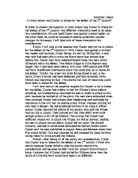To what extent was Custer to blame for the defeat of the 7th Cavalry at The Battle of Little Bighorn?
In 1876 the Army dispatched three columns to attack in coordinated fashion, one of which contained Lt. Colonel George Custer and the seventh cavalry. They planned to attack the Sioux and Cheyenne Indians who had defiantly left their reservations to gather in Montana with the great warrior Sitting Bull to fight for their lands.
'What happened to Custer and his men is not clear as there were no survivors from his force'
Custer was born in New Rumley, Ohio, and spent much of his childhood with a half-sister in Monroe, Michigan. He enrolled in West Point immediately after high school and failed disgustingly to distinguish himself in any positive way. A few days after graduating last in his class, he failed in his duty as officer of the guard to stop a fight between to cadets. He was court-marshaled and saved from punishment only by a great need for officers with the outbreak of the Civil War. In the war Custer did quite well, although he always had enormously high casualty rates, though his 'fearless aggression' earned him respect of his commanding generals and kept him on the public eye. In July 1866 Custer was appointed lieutenant colonel of the seventh cavalry, and in late 1867 Custer was court-martialed and suspended from duty for being absent from duty during the campaign, but was later called back to duty in 1868 and redeemed himself (at least in the eyes of the army) in late November. In 1876 Custer had a march testimony on Indian Service corruption which so infuriated President Ulysses S. Grant that he relieved Custer of his command and replaced him with General Alfred Terry, but because of 'popular disgust' Grant was forced to reverse his decision, Custer went west to meet his destiny.
In 1876 the Army dispatched three columns to attack in coordinated fashion, one of which contained Lt. Colonel George Custer and the seventh cavalry. They planned to attack the Sioux and Cheyenne Indians who had defiantly left their reservations to gather in Montana with the great warrior Sitting Bull to fight for their lands.
'What happened to Custer and his men is not clear as there were no survivors from his force'
Custer was born in New Rumley, Ohio, and spent much of his childhood with a half-sister in Monroe, Michigan. He enrolled in West Point immediately after high school and failed disgustingly to distinguish himself in any positive way. A few days after graduating last in his class, he failed in his duty as officer of the guard to stop a fight between to cadets. He was court-marshaled and saved from punishment only by a great need for officers with the outbreak of the Civil War. In the war Custer did quite well, although he always had enormously high casualty rates, though his 'fearless aggression' earned him respect of his commanding generals and kept him on the public eye. In July 1866 Custer was appointed lieutenant colonel of the seventh cavalry, and in late 1867 Custer was court-martialed and suspended from duty for being absent from duty during the campaign, but was later called back to duty in 1868 and redeemed himself (at least in the eyes of the army) in late November. In 1876 Custer had a march testimony on Indian Service corruption which so infuriated President Ulysses S. Grant that he relieved Custer of his command and replaced him with General Alfred Terry, but because of 'popular disgust' Grant was forced to reverse his decision, Custer went west to meet his destiny.

This is a preview of the whole essay
Teacher Reviews
Here's what a teacher thought of this essay
Final Comment. Star rating *** Over all this essay shows excellent knowledge and understanding of the event, but has fallen in to the trap of tellling the story of the battle rather than examining arange of factors. THe essay could have been structured around weighing up 3 key factors. For example Custer's role, the strength and skill of the Idian forces and bad luck in terms of the failure of the rest of the army.








